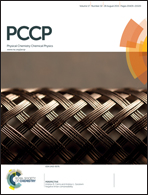Accurate quantum chemical modelling of the separation of Eu3+ from Am3+/Cm3+ by liquid–liquid extraction with Cyanex272†
Abstract
The experimentally observed extraction complexes of trivalent lanthanide Eu3+ and actinide Am3+/Cm3+ cations with Cyanex272 [bis(2,4,4-trimethylpentyl) phosphinic acid, denoted as HC272] and Cyanex301 [bis(2,4,4-trimethylpentyl) dithiophosphinic acid, denoted as HC301] have been studied by using relativistic energy-consistent 4f- and 5f-in-core pseudopotentials for trivalent f elements, combined with density functional theory and a continuum solvation model. It has been found that, as a result of hydrogen bonding, HC272 exists primarily as a self-associated species, whereas HC301 is preferably a monomer. The calculations show that in case of all three M3+ (M = Eu, Am, Cm) ions for HC272 the extraction complexes M[H(C272)2]3 are formed prior to M(C272)3, whereas for HC301 the extraction complexes M(C301)3 have priority over M[H(C301)2]3. The calculated M–O and M–S bond lengths and the M–P distances of these preferred extraction complexes agree very well with the available experimental data. The obtained changes of the Gibbs free energies in the liquid–liquid extraction reactions (1): Maqu3+ + 3(HC272)2,org → M[H(C272)2]3,org + 3Haqu+ and (2): Maqu3+ + 3HC301org → M(C301)3,org + 3Haqu+ agree with the experimentally observed thermodynamical priorities of HC272 and HC301, i.e., HC272 prefers Eu3+ over Am3+/Cm3+ and HC301 prefers Am3+/Cm3+ over Eu3+. The obtained changes of the Gibbs free energies in reaction (2) (Eu, 68.1 kJ mol−1; Am, 46.5 kJ mol−1) agree quite well with the experimental findings (Eu, 63.3 kJ mol−1; Am, 44.1 kJ mol−1).


 Please wait while we load your content...
Please wait while we load your content...